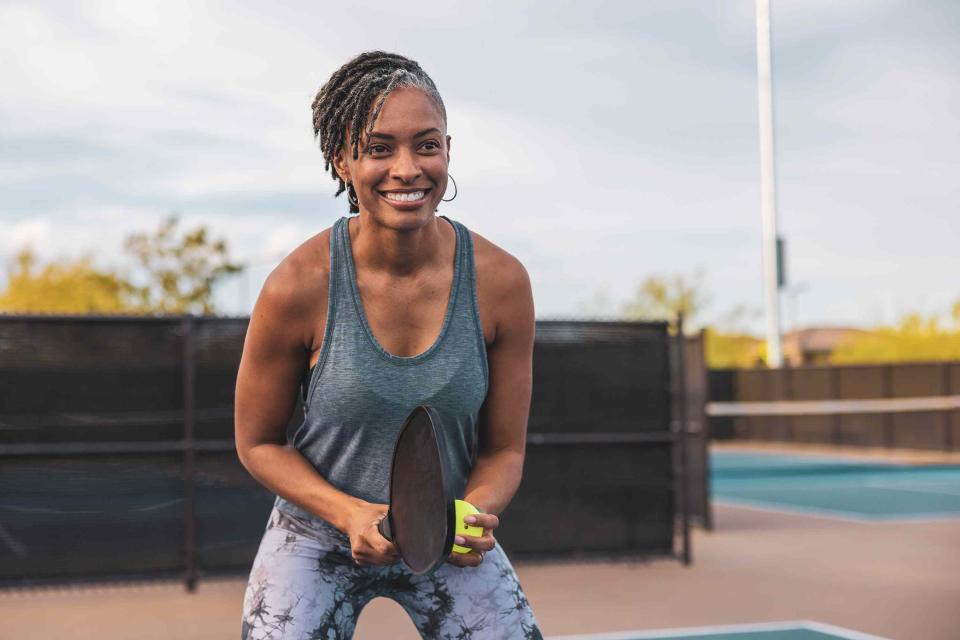Level Up Your Pickleball Game with These Expert Tips
7 Actionable Ways to Serve Up Your Best Game

Getty Images
Pickleball isn't just your grandma's game. If you spend an hour on the court with Pickleball pro, Tyson McGuffin, you'll understand why. The athlete, pickleball teacher, and dad is currently one of Professional Pickleball's most accomplished players: he's a five-time Grand Slam Champion and four-time National Champion. His energy, smile, and signature hair bring a youthful, contagious energy that will inspire you to locate your local court and learn to dink, volley, and lob. If you're already a regular player (or even if you're a newbie pickler), McGuffin offers these pro tips to take your game to the next level.
Less is More
If you're a veteran tennis player, or you're just super competitive, you may be compelled to crush the ball the first chance you get. While it's tempting, McGuffin advises against this tactic. "I always tell newer players that less is more, or the less you have going on, the less there is that can go wrong," he says. "Rather than rushing the game, make more thoughtful movements on the pickleball court so there’s less room for errors." This strategic approach will reduce the chance of errors, especially as you're learning the rules of the game. After all, keeping the ball in play and trying to outlast your opponent may prove to be more fruitful than an overhead or drop shot.
Power and Control Come From the Ground Up
Like most racket sports, power comes from your legs, not necessarily your arms. "All your power and control comes from the ground up," advises McGuffin. "Use big body parts like legs and shoulders versus the wrist and standing upright." Remaining in a semi-squatting 'ready position' and shifting your weight will pay off in terms of ball control and power.
Early Preparation is Key
Remaining alert and ready can help you to get in position to make solid contact with the ball and the sweet spot of the racket. "Get your feet and hands in the right positioning as early as possible," instructs McGuffin. The fastest way to better accuracy and increased power is simply getting back to your ready position ASAP after your last shot.
Take It Slow
Slow and steady reign supreme, even in pickleball. This is particularly relevant advice for beginners. "Newer players have a natural tendency to want to rush the game, especially if they feel uncomfortable on the court," says McGuffin. "I always remind new pickleball players that they have more time than they think. It’s important to be in the correct positioning before your opponent makes contact with the ball." Being in the correct position at this point allows you to track your opponent's shot and be in the best spot to return it.
Control the Kitchen
If you're new to pickleball, one of the most important areas to learn on the court is called the 'kitchen.' This area between the net and the first white line (aka the non-volley line) is a non-volley zone, meaning you have to let the ball bounce before you hit it. The kitchen is a key part of the pickleball strategy. "The game is won and lost at the kitchen line," states McGuffin. "The team that is able to control the kitchen line better has a huge advantage. So, it is important to hone in on those skills."
Invest in Quality Gear
"To focus on your game, you need to have the right gear," advises McGuffin. While it's obvious that you need a pickleball racket and ball, investing in a pair of pickleball shoes is also important to take your game to the next level. Unfortunately, typical running shoes fall short. McGuffin swears by the Skechers Viper Court Pro pickleball shoes that he's been competing and training in since last spring. "The enhanced grip and traction help with stability and can handle the quick movements I like to make on the court," says McGuffin.
Related: The Best Pickleball Clothing for Every Dink, Drop Shot, and Volley
Point Your Belly Button At Your Target While Serving
In pickleball, the underhand serve must be hit deep and back to the diagonally opposite service" box. The purpose of a serve is simply to put the ball in play, but placement is important. "While serving, your tossing arm should be facing the net post, your hips and belly button should be facing the target, and the palm of your dominant hand guides the shot," instructs McGuffin. "You must also serve cross-court into the opposite box and aim for depth to push the returner back." Game on!
For more Shape news, make sure to sign up for our newsletter!
Read the original article on Shape.

